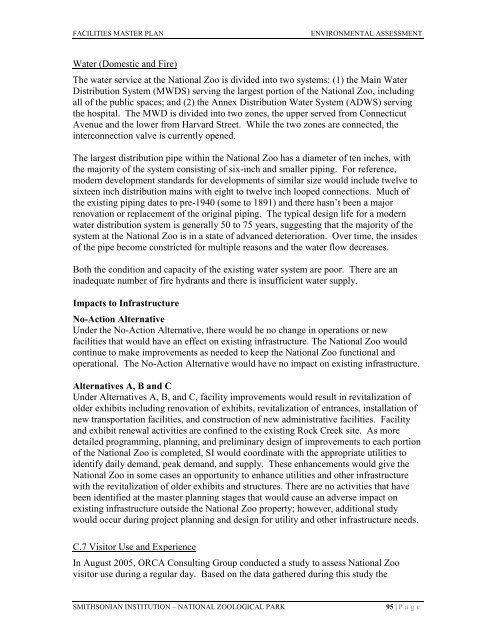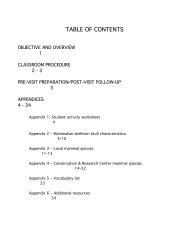facilities renewal master plan - National Zoo - Smithsonian Institution
facilities renewal master plan - National Zoo - Smithsonian Institution
facilities renewal master plan - National Zoo - Smithsonian Institution
You also want an ePaper? Increase the reach of your titles
YUMPU automatically turns print PDFs into web optimized ePapers that Google loves.
FACILITIES MASTER PLAN ENVIRONMENTAL ASSESSMENT<br />
Water (Domestic and Fire)<br />
The water service at the <strong>National</strong> <strong>Zoo</strong> is divided into two systems: (1) the Main Water<br />
Distribution System (MWDS) serving the largest portion of the <strong>National</strong> <strong>Zoo</strong>, including<br />
all of the public spaces; and (2) the Annex Distribution Water System (ADWS) serving<br />
the hospital. The MWD is divided into two zones, the upper served from Connecticut<br />
Avenue and the lower from Harvard Street. While the two zones are connected, the<br />
interconnection valve is currently opened.<br />
The largest distribution pipe within the <strong>National</strong> <strong>Zoo</strong> has a diameter of ten inches, with<br />
the majority of the system consisting of six-inch and smaller piping. For reference,<br />
modern development standards for developments of similar size would include twelve to<br />
sixteen inch distribution mains with eight to twelve inch looped connections. Much of<br />
the existing piping dates to pre-1940 (some to 1891) and there hasn’t been a major<br />
renovation or replacement of the original piping. The typical design life for a modern<br />
water distribution system is generally 50 to 75 years, suggesting that the majority of the<br />
system at the <strong>National</strong> <strong>Zoo</strong> is in a state of advanced deterioration. Over time, the insides<br />
of the pipe become constricted for multiple reasons and the water flow decreases.<br />
Both the condition and capacity of the existing water system are poor. There are an<br />
inadequate number of fire hydrants and there is insufficient water supply.<br />
Impacts to Infrastructure<br />
No-Action Alternative<br />
Under the No-Action Alternative, there would be no change in operations or new<br />
<strong>facilities</strong> that would have an effect on existing infrastructure. The <strong>National</strong> <strong>Zoo</strong> would<br />
continue to make improvements as needed to keep the <strong>National</strong> <strong>Zoo</strong> functional and<br />
operational. The No-Action Alternative would have no impact on existing infrastructure.<br />
Alternatives A, B and C<br />
Under Alternatives A, B, and C, facility improvements would result in revitalization of<br />
older exhibits including renovation of exhibits, revitalization of entrances, installation of<br />
new transportation <strong>facilities</strong>, and construction of new administrative <strong>facilities</strong>. Facility<br />
and exhibit <strong>renewal</strong> activities are confined to the existing Rock Creek site. As more<br />
detailed programming, <strong>plan</strong>ning, and preliminary design of improvements to each portion<br />
of the <strong>National</strong> <strong>Zoo</strong> is completed, SI would coordinate with the appropriate utilities to<br />
identify daily demand, peak demand, and supply. These enhancements would give the<br />
<strong>National</strong> <strong>Zoo</strong> in some cases an opportunity to enhance utilities and other infrastructure<br />
with the revitalization of older exhibits and structures. There are no activities that have<br />
been identified at the <strong>master</strong> <strong>plan</strong>ning stages that would cause an adverse impact on<br />
existing infrastructure outside the <strong>National</strong> <strong>Zoo</strong> property; however, additional study<br />
would occur during project <strong>plan</strong>ning and design for utility and other infrastructure needs.<br />
C.7 Visitor Use and Experience<br />
In August 2005, ORCA Consulting Group conducted a study to assess <strong>National</strong> <strong>Zoo</strong><br />
visitor use during a regular day. Based on the data gathered during this study the<br />
SMITHSONIAN INSTITUTION – NATIONAL ZOOLOGICAL PARK 95 | P a g e

















